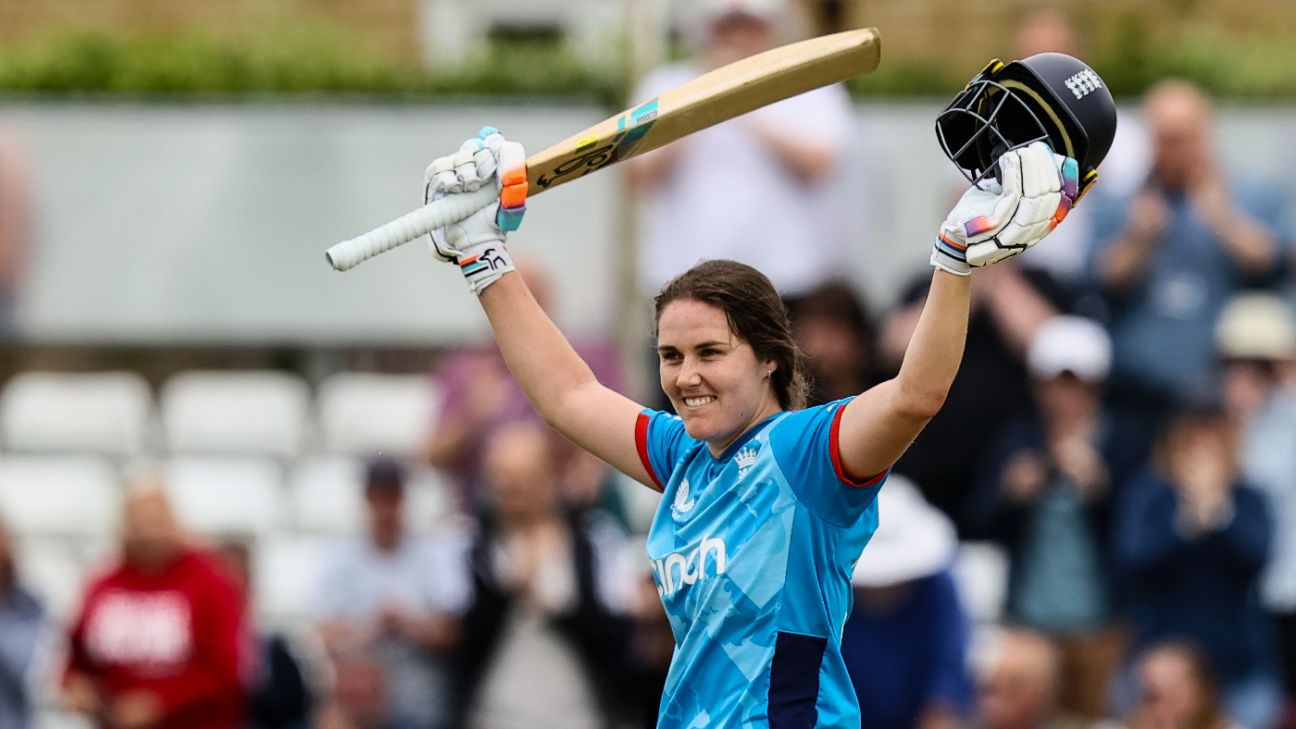Cricket
Nat Sciver-Brunt: ‘Being myself and free is the best way of displaying Pride’

“I didn’t really think at the time it would blow up as much as it did,” Nat Sciver-Brunt says. “It just felt like the normal reaction, I guess.”
It is a beautiful shot. There they stand, among a throng in the middle of the Hagley Oval, and somehow alone together. Love and pain in oddly comfortable harmony.
“I like the photo,” Nat adds. “Well, I like the photo more for Katherine’s face than what’s gone on in the game.”
This intimate shot of England cricket’s first openly same-sex couple went viral on social media. Though the pair don’t really indulge beyond “the odd scroll here and there”, they were aware of the volume of positivity sent their way for being themselves and being so visible while at the peak of their sport. It is something they hear first-hand, too.
“You might be signing autographs, and people will say little bits to me and Katherine as well. In that way, it’s quite nice that it’s in-person, and people are able to say directly to us how either we’ve inspired them, or they’re really happy for us.”
Those comments reinforce the role cricket can play in the LGBTQ community. This year, England Cricket are celebrating the Rainbow Laces between June 29 and July 7, with professional and recreational clubs marking the campaign at games across the country. An array of representatives from English cricket – beyond simply the ECB – will also march in the Pride in London parade.
Unfortunately, Sciver-Brunt has yet to attend a Pride march because of the regular clash with cricket. This year, it’s the second of a three-match ODI series against New Zealand, which begins on Wednesday. “I suppose I have to do my work in other spaces,” she says.
“I guess being myself and being free in that is my best way of displaying that. Me and Katherine being who we are, together in public and just being normal about it all, really – that’s our way of being part of Pride. Pride to me is being comfortable enough to be who you are, and not having to hide it. That’s our way of being part of the march.”
Achieving that “comfort” has come in stages for Sciver-Brunt.
“I’m not really sure if there were any gay people at school,” she says. “There’s something about moving away from home and probably not having the expectations of your family, or living under that roof. You’re sort of left to your own devices and working out your own way of doing things.
“Going to uni and not having anyone to tell you what to do or anything like that. People grow up in that phase, don’t they?”
“There was no hiding within the team,” Sciver-Brunt says, when asked about coming out via the engagement. “It was just a matter of timing before doing a few media interviews around it.
“Being in the public eye sort of found me, rather than seeking it out, if you know what I mean? I had to spend time in that space before feeling comfortable about it. I do now.”
There were still aspects to overcome. She used to put her left hand in her pocket to hide her engagement ring to avoid awkward conversations about her relationship. Now, the only awkwardness comes from forgetting to put her wedding ring back on.
“Katherine’s always like – ‘get that ring out, you show people!’ It feels weird when I forget to put it back on, actually. I take it off quite a lot and I don’t always remember to put it back on – but not through not wanting to put it back on!
“But people are, I don’t know, more understanding, more welcoming, feel more inclusive. It’s not a thought in my mind to hide it.”
She laughs when this matrimony streak is brought up. It has been a point of conversation in the dressing-room.
“Well, Kate Cross actually told me when we were playing against Pakistan in that final game (when she scored that ninth WODI century). So, I sort of roughly know the stats.
“But I need to tell Katherine the actual numbers now. Because I’m sure she’ll be like ‘see, well, it’s inevitable. You’ve got married to me, obviously – it was always going to happen’.”
She cannot pinpoint what changed. But she does know it goes beyond watching the ball and holding better shapes into her more full-blooded slaps down the ground.
“Maybe it’s more maturity? Or knowing what I need as a cricketer? What my best training would be like? What best prepares me for a game? Just being mentally ready for those challenges. And probably after I took a break from cricket (in 2022), I feel more comfortable knowing where I am mentally.
“It coincided with everything just clicking, I guess? More people should just get married, shouldn’t they?”
Cricketers often say having kids also has a liberating effect on their output. Sciver-Brunt grins: “Well yeah … look out!”
“You start with going to see the doctors, and you’re injecting yourself every day. From start to finish, it’s about three or four weeks until you start feeling right to push yourself in training.
“Finding the time was difficult, but ultimately, if it’s something really important to you, you just do it whenever you’re ready. Cricket will be there when you get back. It’ll be waiting for you.”
It certainly will be for some time. Series victories over Pakistan now lead into a ODI and T20I series against New Zealand. Another season with Trent Rockets in the women’s Hundred follows before matches against Ireland ahead of the T20 World Cup in Bangladesh – all before November.
“I’m sort of raring to go again, which is nice.”
Nice for Sciver-Brunt, nice for England and nice for those who see her as an inspiration.
Vithushan Ehantharajah is an associate editor at ESPNcricinfo










